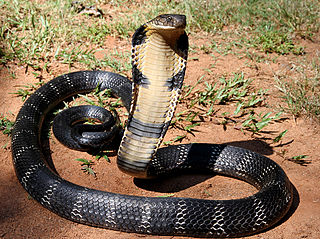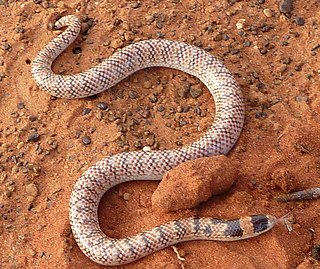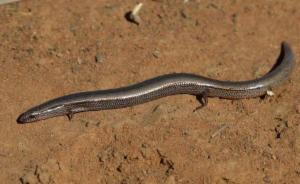
Elapidae is a family of snakes characterized by their permanently erect fangs at the front of the mouth. Most elapids are venomous, with the exception of the genus Emydocephalus. Many members of this family exhibit a threat display of rearing upwards while spreading out a neck flap. Elapids are endemic to tropical and subtropical regions around the world, with terrestrial forms in Asia, Australia, Africa, and the Americas and marine forms in the Pacific and Indian Oceans. Members of the family have a wide range of sizes, from the 18 cm (7.1 in) white-lipped snake to the 5.85 m king cobra. Most species have neurotoxic venom that is channeled by their hollow fangs, and some may contain other toxic components in various proportions. The family includes 55 genera with some 360 species and over 170 subspecies.

The eastern brown snake, often referred to as the common brown snake, is a species of highly venomous snake in the family Elapidae. The species is native to eastern and central Australia and southern New Guinea. It was first described by André Marie Constant Duméril, Gabriel Bibron, and Auguste Duméril in 1854. The adult eastern brown snake has a slender build and can grow to 2 m (7 ft) in length. The colour of its surface ranges from pale brown to black, while its underside is pale cream-yellow, often with orange or grey splotches. The eastern brown snake is found in most habitats except dense forests, often in farmland and on the outskirts of urban areas, as such places are populated by its main prey, the house mouse. The species is oviparous. The International Union for Conservation of Nature classifies the snake as a least-concern species, though its status in New Guinea is unclear.

The short-nosed snake is a species of venomous snake in the family Elapidae. The species is endemic to Australia. Short-nosed snakes are endemic to swamplands and coastlands in the southwest of Western Australia, where they shelter in nests of stick ants, as well as dense rushes and reed tussocks. Short-nosed snakes are known to prey on small skinks mainly from the skink genus hemiergis, and small species of frogs.

Simoselaps, or Australian coral snakes, is a genus composed of 12 species of venomous elapid snakes.

Brachyurophis is a genus of elapid snakes known as shovel-nosed snakes, so named because of their shovel-nosed snout which is used to burrow. The genus has eight recognized species, which are all found in Australia.

The bandy-bandy, also commonly known as the hoop snake, is a species of venomous snake in the family Elapidae. The word bandy-bandy (bandi-bandi) traces back to the indigenous dialect of Kattang, from the Taree region, New South Wales. There are 5 known species of bandy-bandy, all of which are endemic to Australia.

The southern sandslider is a species of skink or Scincidae. The species is endemic to Australia and widespread across the continent, being most commonly found within sandy termite mounds. This is where they take safe refuge from the harsh Australian climate and various ground predators.
The collared whipsnake is a medium-sized elapid endemic to Australia. It is found in rainforest edges and other tropical woodland areas as well as in rocky habitat and environments on offshore islands.
The ghost skink is a species of skink endemic to Australia. Commonly known as the Ghost skink because of its faded dorsolateral banding when compared to other banded Erimiascincus species that have well-defined dorsolateral banding on their backs.

The broad-banded sand-swimmer or Richardson's skink is a species of skink found in Australia.

Lerista timida, the dwarf three-toed slider or wood mulch-slider, is a species of skink found in Australia. Other common names for the species include timid slider and dwarf burrowing skink. The skink is a member of the Lerista genus which are confined to continental Australia and are mostly a burrowing species of skink. The genus consists of consists elongated, smooth-scaled, Fossorial lizards that are specialized for life in the upper soils and dry leaf litter through which they slide using Lateral undulation as a form of locomotive action, giving rise to their nickname as sliders. They normally emerge of a night-time to hunt for small Invertebrates such as ants, termites and insects. If disturbed, they dive immediately into any loose substrate to avoid predation, this behavior leaves behind a distinctive disrupted wavy track that often found on sandy flats or dunes, roads and tracks.
Brachyurophis incinctus is a species of snake from the family Elapidae, commonly named the unbanded shovel-nosed snake, and is a species endemic to Australia. Its common name reflects its shovel nose specialisation, burrowing behaviour and the fact that it is not banded on its body.

Brachyurophis australis(coral snake) is a species of snake from the family Elapidae (common names - eastern shovel-nosed snake, coral snake, Australian coral snake) and is a species endemic to Australia. Its common name reflects its shovel nose specialisation.
Brachyurophis approximans, also known as the north-western shovel-nosed snake, is a species of mildly venomous burrowing snake that is endemic to Australia. The specific epithet approximans (“approaching”) alludes to its similarity to Brachyurophis campbelli.
Brachyurophis campbelli, also known as the Cape York shovel-nosed snake or Einasliegh shovel-nosed snake, is a species of mildly venomous burrowing snake that is endemic to Australia. The specific epithet campbelli honours a Mr W.D. Campbell who collected the type specimen in 1928 in the vicinity of Almaden, Queensland.
Brachyurophis roperi, also known as the northern shovel-nosed snake, is a species of mildly venomous burrowing snake that is endemic to Australia. The specific epithet roperi refers to the type locality of the Roper River Mission in the Northern Territory. It was formerly considered a subspecies of Brachyurophis semifasciatus.
Brachyurophis morrisi, also known as the Arnhem shovel-nosed snake, is a species of mildly venomous burrowing snake that is endemic to Australia. The specific epithet morrisi honours author and naturalist Ian James Morris for his contributions to knowledge of the animals of the Northern Territory, who first collected the species in 1970.











